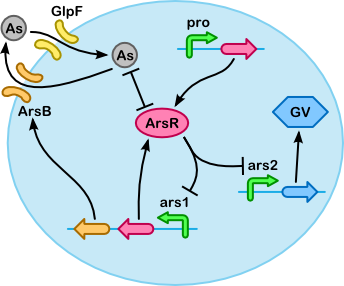Team:Groningen/Modelling
From 2009.igem.org
(→Models: Image as link to modelling page.) |
(The purpose of modelling.) |
||
| Line 3: | Line 3: | ||
[[Category:Team:Groningen/Roles/Modeller|Modelling]] | [[Category:Team:Groningen/Roles/Modeller|Modelling]] | ||
| - | + | Modelling is an integral part of synthetic biology and most of our modelling results are therefore integrated with our theoretical information and lab results on our [[Team:Groningen/Project|project pages]]. In general we have tried to make as much of our model as possible interactively available on our wiki. Specifically, we have constructed several interactive calculators that can be used to explore our model, some including interactive [https://2009.igem.org/Template:Graph graphs] to show the results. | |
| - | + | In our project we use modelling for the following purposes: | |
| + | |||
| + | *'''Description''' of our system. By modelling the system the different relationships between components in our system are made explicit. | ||
| + | *'''Gaining insight''' in our system. Having modelled our system we can see how different variables interact, giving essential insights into how our system functions. | ||
| + | *'''Verification''' of our design. For example, we looked at the number of gas vesicles needed to let our cells float, to check whether it should be possible. | ||
| + | *'''Making design choices'''. We have shown that constitutive expression of ArsR can indeed significantly increase accumulation levels, and we would be able to show the impact of this constitutively expressed ArsR regulating the ars promoter on the expression of the GVP cluster {{todo}}. | ||
| + | *'''Designing tests'''. By looking at the behaviour of GlpF/ArsB (importer/exporter for As(III)) we determined what range of concentrations would be interesting to use in our uptake experiments. | ||
| + | *{{todo}}'''Analysis''' of results. Once we have uptake experiments (and new promoter measurements?) we could try to analyze the results to estimate further constants and/or explain the results. | ||
| + | |||
| + | Our initial ideas on how and what to model (including a survey of previously used software) can be found at [[Team:Groningen/Brainstorm/Modelling|Brainstorm/Modelling]]. | ||
==Models== | ==Models== | ||
| - | Apart from | + | Apart from our physical model of [[Team:Groningen/Project/Vesicle|gas vesicles]] we have the following reaction model involving import, export and accumulation of arsenic (showing the "reactions" in the model): |
<center>{{LinkedImage|Arsenic_filtering.png|Team:Groningen/Modelling/Arsenic}}<br/>(Click to go to our detailed [[Team:Groningen/Modelling/Arsenic|modelling page]].)</center> | <center>{{LinkedImage|Arsenic_filtering.png|Team:Groningen/Modelling/Arsenic}}<br/>(Click to go to our detailed [[Team:Groningen/Modelling/Arsenic|modelling page]].)</center> | ||
| - | == Kinetic Laws == | + | <!--== Kinetic Laws == |
{{todo}} Add references. | {{todo}} Add references. | ||
| Line 29: | Line 38: | ||
See http://www.biomodels.net/ for a database of models. | See http://www.biomodels.net/ for a database of models. | ||
| - | + | --> | |
| - | + | ||
| - | + | ||
| - | + | ||
| - | + | ||
| - | + | ||
| - | + | ||
| - | + | ||
| - | + | ||
| - | + | ||
| - | + | ||
| - | + | ||
Revision as of 09:28, 11 September 2009
Modelling
|
|---|
Modelling is an integral part of synthetic biology and most of our modelling results are therefore integrated with our theoretical information and lab results on our project pages. In general we have tried to make as much of our model as possible interactively available on our wiki. Specifically, we have constructed several interactive calculators that can be used to explore our model, some including interactive graphs to show the results.
In our project we use modelling for the following purposes:
- Description of our system. By modelling the system the different relationships between components in our system are made explicit.
- Gaining insight in our system. Having modelled our system we can see how different variables interact, giving essential insights into how our system functions.
- Verification of our design. For example, we looked at the number of gas vesicles needed to let our cells float, to check whether it should be possible.
- Making design choices. We have shown that constitutive expression of ArsR can indeed significantly increase accumulation levels, and we would be able to show the impact of this constitutively expressed ArsR regulating the ars promoter on the expression of the GVP cluster TODO.
- Designing tests. By looking at the behaviour of GlpF/ArsB (importer/exporter for As(III)) we determined what range of concentrations would be interesting to use in our uptake experiments.
- TODOAnalysis of results. Once we have uptake experiments (and new promoter measurements?) we could try to analyze the results to estimate further constants and/or explain the results.
Our initial ideas on how and what to model (including a survey of previously used software) can be found at Brainstorm/Modelling.
Models
Apart from our physical model of gas vesicles we have the following reaction model involving import, export and accumulation of arsenic (showing the "reactions" in the model):

(Click to go to our detailed modelling page.)
 "
"
